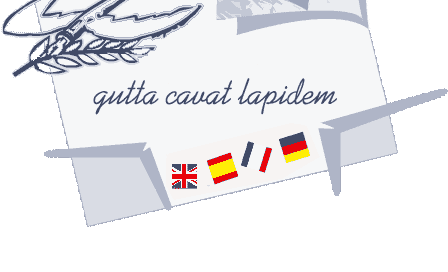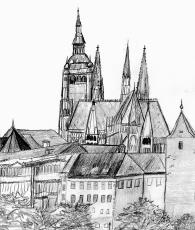
 |


Si vis pacem, cole justitiam !
 |
| 
 Si vis pacem, cole justitiam ! |
|
Nelson Mandela (1918- ) Nelson Rolihlahla Mandela deserves a place in this encyclopaedia because of his life struggle against Apartheid in South Africa, a practice universally condemned as a “crime against humanity.” (see UN General Assembly Resolutions 3068 (XXVIII) of November 30, 1973, Nos. 41/103, 43/97, 44/69, 45/90, 46/84, 47/81, 48/89). Article 1 of the International Convention on the suppression and Punishment of the Crime of Apartheid (adopted by the General Assembly on November 30, 1973, in force July 18, 1976) stipulates: “The States Parties to the present Convention declare that apartheid is a crime against humanity and that inhuman acts resulting from the policies and practices of apartheid and similar policies and practices of racial segregation and discrimination, as defined in article II of the Convention, are crimes violating the principles of international law, in particular the purposes and principles of the Charter of the United Nations, and constituting a serious threat to international peace and security.” White rule in South Africa meant that some five million whites governed over a population of 25 million blacks, coloured and Indians. As an alternative to apartheid, Mandela offered a plan for a multi-racial society, in which majority black rule would guarantee the welfare of all South Africans, black and white alike. As early as June 1955 he drafted an idealistic program, the “Freedom Charter” containing principles of coexistence and reconciliation, in the same generous spirit as Martin Luther King's “I have a dream” vision. In this context it is also important to highlight Mandela's early struggle against the so-called Bantustan policy launched by the government of Prime Minister Hendrik Verwoerd in 1959, a program that aimed at forcibly resettling parts of the black population into larger reservations or ghettos, called "homelands" (Meredith pp. 155ff), frequently separating the work force from their families. This partly implemented policy of resettlement surely constituted a crime against humanity within the meaning of the Nuremberg judgment, which condemned the Nazi demographic manipulations, including mass deportations, population transfers and internal displacements carried out during the Second World War and affecting nearly one million Poles expelled from the Warthegau into Eastern Poland and more than one hundred thousand French Alsatians expelled into Vichy France. While the African National Congress (ANC) vigorously condemned the 1959 "Promotion of Bantu Self-Government Act", which fragmented the black African population into eight separate black «homelands» (Mereditch p. 156), some tribal leaders accepted the policy and cooperated with the apartheid government. Mandela's vocal opposition to the Bantustan policy exacerbated tensions with the government, and he was repeatedly arrested and harassed, ultimately being charged with high treason and subjected to the "treason trial", which dragged on for several years. In a climate of escalating violence, demonstrations in March 1960 culminated in a massacre at Sharpeville, a town southwest of Johannesburg, in which 69 protesters were killed by the white police. Thereupon, the government declared a state of emergency and banned the ANC. Mandela was again arrested and kept for five months at the prison centre known as Pretoria Local. Quite unexpectedly, when the Treason Trial ended in March 1961, he was found not guilty.. In the summer of 1961 facing the reality that peaceful overtures were met with force, Mandela endorsed the necessity of armed struggle and formed the Umkhonto we Sizwe (the Spear of he Nation) or MK, the military wing of the ANC, which targeted mainly government offices, economic installations and symbols of apartheid. While this may be termed terrorism by some, the historical fact is that national liberation movements in Africa and Asia were left no choice but to use violence in their struggle for de-colonization and self-determination, and that the United Nations recognized the legitimacy of their armed struggle. Early in 1962 Mandela left the country illegally for a period of six months, to canvass in London and elsewhere for financial support for the armed struggle. He took military training in Addis Ababa and addressed the Conference of the Pan African Freedom Movement of East and Central Africa in Ethiopia. Upon his return to South Africa in August 1962 he was arrested, charged with illegal exit and incitement to strike, tried and sentenced to five years' imprisonment. He was first held in Pretoria and then transfered to the maximum security prison at Robben Island, some 7 km off the coast of Cape Town. Although already imprisoned, he was newly indicted on charges of sabotage and attempting to overthrow the government by violence. Mandela's statements from the dock at his trial in Rivonia, a suburb of Johannesburg, constitute classics in the history of resistance movements: "During my lifeltime I have dedicated myself to this struggle of the African people. I have fought against white domination, and I have fought against black domination. I have cherished the ideal of a democratic and free society in which all persons live together in harmony and with equal opportunities. It is an ideal which I hope to live for and to achieve. But if needs be, it is an ideal for which I am prepared to die." (Meredith, p. 268) Mandela escaped capital punishment, but was sentenced to life imprisonment. In all, he spent 27 years in prison, including 18 at Robben Island as prisoner number 466/64, where he worked in a lime quarry (Meredith pp. 281 ff), until he was transferred in March 1982 to Pollsmoor Prison in Cape Town (Meredith p. 344) and in December 1988 to the Victor Verster Prison near Paarl, from where he was released on 11 February 1990 (Meredith, p. 402). Decades of international condemnation of apartheid, accompanied by severe economic sanctions, denial of bank loans, widespread disinvestment in South Africa, international ostracism including exclusion from the General Assembly and from participation in the work of international organizations, persuaded the government that the price of maintaining the apartheid system was too high, even for the white South African population. Thus, in February 1990 President Frederik Willem de Klerk lifted the ban on the ANC and paved the way for a non-violent departure from apartheid. In 1991 at the first national conference of the ANC held inside South Africa, Mandela was elected President of the ANC. In 1992 President de Klerk and Mandela signed a Record of Understanding and established an elected constitutional assembly to develop a new democratic constitution for South Africa. Later they developed the idea of the "truth commissions" aimed at reconciliation of white and black in the post-Apartheid period. Mandela was awarded the Nobel Peace Price in 1993, together with de Klerk. Already in 1984 another opponent of apartheid had been honored with the Nobel Peace Prize, Archbishop Desmond Tutu. From April 26-29 1994 the first al-races election took place in South Africa on the basis of the one-man./one-vote principle. Mandela was elected president and the ANC won 252 of the 400 seats in the national assembly. de Klerk became deputy president. On May 10, 1994 he took office as the first democratically elected president of South Africa and served one term until June 1999. His generosity of spirit and unwillingness to take revenge won him the respect even of his white South African adversaries. Mandela the man Mandela was born on 18 July 1918 in Quno, a village near Umtata in the province of Transkei in the South-Eastern coast of South Africa, near the Indian ocean. A scion of the Madiba tribal clan, he belonged to the Thembu people, his great-grandfather having been a Thembu king. Nelson's father, Gadla Henry Mphakayiswa Mandela, was chief counsellor to the paramount chief of Thembuland. He had four wives and thirteen children, but died untimely in 1927. Young Mandela then became the ward of the chief and was groomed for the chieftainship. He was given the English name Nelson by an African teacher at the local primary school, but he was affectionately known as Madiba by his friends; he attended Healdtown Methodist Boarding School and matriculated for a BA degree at Fort Hare University, where he completed two years before leaving for Johannesburg in 1940, where he completed his degree, did articles of clerkship and met Walter Sisulo, who introduced him to the law firm Witkin, Sidelsky and Eidelman. He attended the University of Witwatersrand and became a lawyer. In 1943 he joined the African National Congress, which had been founded in 1912, its goal being to end white domination and create a multi-racial South Africa. At this time he made friends with the leaders of the Indian community, who were protesting against new legislation restricting their right to purchase land. Mandela observed their practice of peaceful resistance and learned about the philosophy of non-violent disobedience advocated by the Indian lawyer Mohandas Gandhi (Meredith p. 56f). Gandhi had spent 21 years in South Africa helping the Hindu population there to defend their human rights. In 1944 Mandela, together with Oliver Tambo and Walter Sisulu formed the Youth League of the African National Congress (ANC), which had been founded already in 1912 for the purpose of ending white domination and furthering a multi-racial society. The Youth League was impatient with the slow pace of progress and was determined to make the ANC an activist organization. Also in 1944 Mandela married Evelyn Mase, a nursing student who had grown up in Thembuland. He had three children with Evelyn, but divorced her in 1957. In June 1958, he married Winni Madikiyela, a social worker from Pondoland. She bore him two daughers, Zenani and Zindzi. In 1948 the white National Party came to power under Dr. Daniel Malan, whose platform was called apartheid , or “apartness”. The National party enacted new laws providing for racial segregation, including the Separate Representation of Voters Act and the Prohibition of Mixed Marriages Act. In 1949 the ANC Youth League drafted a program of action calling for mass strikes, boycotts and passive resistance. As a response, the National Party passed the Suppression of Communism Act, the Population and Registration Act, and the Group Areas Act, aimed at enforcing apartheid policies and crushing any mass movement. As a member of the ANC executive committee since 1949, Mandela organized in 1952 the “Defiance Campaign”, a non-violent mass resistance movement against the apartheid laws. Also in 1952 Mandela and Oliver Tambo opened a lawfirm in downtown Johannesburg, the first black law firm in South Africa, especializing in defending black South-Africans from the injustices associated with the apartheid laws, particularly the « pass laws » that restricted freedom of residence and movement. From 1962 to 1990 he was imprisoned, and his wife Winnie became a focal point of ANC activity. Mandela, however, remained very much a public figure and his stature continued to grow over time. Although imprisoned, he was invited by President P.W. Botha in July 1989 to a personal meeting in order to discuss models for a transition. In December 1989 he held the first of several meetings with President de Klerk. In 1992 he announced his separation from Winnie, from whom he was officially divorced in March 1996. Her personal and political misjudgments had caused him much sadness. Also in 1996 he formed an attachment with Graca Machel, the widow of the former President of neighbouring Mozanbique. They were married on Mandela's eightieth birthday, on July 18, 1998. He is now retired from politics and lives with his Graca in a red brick house on a hill in his native Quno in the Transkei. He has four living children, 23 grandchildren and a growing number of great-grandchildren. In September 2001 a World Conference Against Racism was held in Durban, South Africa, during which Mandela's achievements in the struggle against apartheid and in the building of a multi-racial society were honoured. Mandela's legacy is a nw south Africa that enjoys greater racial harmony thane ver before and a quality of reconciliation which remains an example for other conflict-ridden societies. In historical and human rights terms, Mandela shall remain one of the heroes of twentieth century. Bibliography Documents: International Convention on the Suppression and Punishment of the Crime of Apartheid (adopted and opened for signature and ratification by General Assembly resolution 3068 (XXVIII) of November 30. 1973, entry into force July 18, 1976) International Convention against Apartheid in Sports (adopted and opened for signature and ratification by General Assembly resolution 40/64 of December 10, 1985) Convention on the Non-applicability of Statutory Limitations to War Crimes and Crimes Against Humanity , adopted by the UN General Assembly on November 26, 1968, entered into force November 11, 1970. World Conference Against Racism, Declaration and Programme of Action (2001), Durban, South Africa, August 31-September 8, 2001 (2002) United Nations Department of Information, New York DPI/2261. Human Rights and population transfer , final report of the Special Rapporteur Mr. Al-Khasawneh, UN Doc. E/CN.4/Sub.2/1997/23 (June 1997) Adam, H., South Africa without Apartheid , Dismantling Racial Discrimination (1986). Alexander, Neville. Robben Island Prison Dossier 1964-1974 (1994) . UCT Press, Cape Town. Benson, Mary. Nelson Mandela. The Man and the Movement (1986). W.W.Norton, New York. Blumenfeld, J. (ed). South Africa in Crisis (1987). Davenport, T.R.H. South Africa. A Modern History (1991) Macmillan, London. Deacon, Harriet (ed.) The Island. A History of Robben Island, 1488-1990 (1992). David Philip, Cape Town. De Klerk, Willem, F.W. de Klerk. The Man in His Time (1991). Jonathan Ball, Johannesburg. Delbruck, Jost. “Apartheid” in Bernhardt (ed.), Encyclopaedia of Public International Law (1992), Vol. I, pp. 192-196. Dugard, J. Human Rights and the South African Legal Order (1978). Hampton, Jane, Internally Displaced People. A Global Survey (1998). Holland, Heidi. The Struggle. A History of the African National Congress (1989) Grafton, London. Karis, Thomas, G. Carter and G. Gerhart (eds). From Protest to Challenge. A Documentary History of African Politics in south Africa (1972-7). 4 vols., Hoover Institution Press, Stanford. Mandela, Nelson, Long Wakt to Freedom, the Autobiography of Nelson Mandela (1994). Little, Brown and Company, Boston. Mandela, Nelson, Nelson Mandela Speaks. Forging a Democratic, Non-racial South Africa (1993). Pathfinder, New York. Mandela, Winnie, Part of My Soul (1985). Penguin, Harmondsworth. Meredith, Martin. Nelson Mandela. A Biography (1998). St. Martin's Press, New York. Ozgur, O. Apartheid, The United Nations and Peaceful Change in South Africa (1982). Price, Robert M. The Apartheid State in Crisis (1991) Oxford University Press, New York. Richardson, H.J. “Self-determination, International Law and the South African Bantustan Policy” (1978) in Columbia Journal of Transnational Law , vol. 17, pp. 185-219. Sampson, Anthony. Mandela. The Authorized Biography (1999). A.A. Knopf, New York. Wilson, Monica, and Thompson, Leonard (eds.), The Oxford History of South Africa (1969, 1971) 2 vols., Clarendon Press, Oxford. Wolpe, H. Race, Class and the Apartheid System (1988). de Zayas, Alfred. "Forced resettlement" in R. Bernhardt (ed.), Encyclopaedia of Public International Law (1995) vol. II, pp. xxx; "Population, Expulsion and Transfers" (1998), vol. III. pp. xxx . |
| Copyright ©2004-2006 Alfred De Zayas. All contents are copyrighted and may not be used without the author's permission. This page was created by Nick Ionascu. |